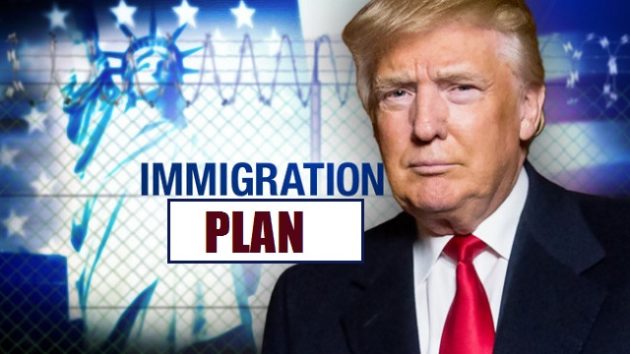President Trump’s Immigration Challenge: To undo Obama’s catastrophic damage
On January 20, 2017 President Trump can and likely will end all of Obama’s illegal immigration executive orders, but he needs to do more.
For decades the effective enforcement of our nation’s immigration laws was hobbled by lack of resources in general and a particularly devastating failure to enforce the immigration laws from within the interior of the United States.
For decades the Border Patrol was perceived as the primary enforcement arm of America’s immigration laws and for the Border Patrol this worked out fine. They got the lion’s share of publicity and, far more importantly, the funding while INS special agents and the interior enforcement mission were all but ignored
When the DHS (Department of Homeland Security) was created in the wake of the terror attacks of 9/11, the former INS was dismantled and broken into several components of the DHS and mixed in with other agencies, principally the U.S. Customs Service.
Bad as it was for INS agents to operate in the shadow of the Border Patrol, the creation of the DHS was disastrous and caused many of the INS agents nostalgic for “the good old days.”
On May 5, 2005 the House Subcommittee on Immigration, Border Security and Claims conducted a hearing on the topic, “New ‘Dual Mission’ Of The Immigration Enforcement Agencies.”
I was one of four witnesses who testified at that hearing. In point of fact, I testified at several hearings that sought to understand the challenges that the creation of the DHS created for the effective enforcement of our nation’s immigration laws.
In my testimony I clearly articulated my concerns about the myriad issues created when the DHS was established and the former INS was dismantled.
Consider this excerpt from the testimony of then-Subcommittee Chairman John Hostettler in which he articulated the importance of immigration law enforcement and that was, however, hobbled by the creation of the DHS:
The first two Subcommittee hearings of the year examined in detail how the immigration enforcement agencies have inadequate resources and too few personnel to carry out their mission. The witnesses mentioned the lack of uniforms, badges, detention space, and the inevitable low morale of frontline agents who are overwhelmed by the sheer volume of incoming illegal aliens. If this were not enough, these ”immigration enforcement” agencies also face internal confusion resulting from dual or multiple missions in which immigration has all too often taken a back seat. Sadly, contrary to Congress’ expectations, immigration enforcement has not been the primary focus of either of these agencies, and that is the subject of today’s hearing.
The Homeland Security Act, enacted in November 2002, split the former Immigration and Naturalization Service, or INS, into separate immigration service and enforcement agencies, both within the Department of Homeland Security. This split had been pursued by Chairman Sensenbrenner based on testimony and evidence that the dual missions of INS had resulted in poor performance.
There was a constant tug-of-war between providing good service to law-abiding aliens and enforcing the law against law-breakers. The plain language of the Homeland Security Act, Title D, creates a ”Bureau of Border Security,” and specifically transfers all immigration enforcement functions of INS into it. Yet when it came down to actually creating the two: new agencies, the Administration veered off course. Although the service functions of INS were transferred to USCIS, the enforcement side of INS was split in two, what is now Immigration and Customs Enforcement, or ICE, to handle interior enforcement, and Customs and Border Protection (CBP) to guard our borders.
ICE was given all Customs agents, investigators, intelligence and analysis-from the Treasury Department, as well as the Federal Protective Service to guard Federal buildings, and the Federal Air Marshals to protect our airplanes, and finally the INS investigators.
CBP was given all Treasury Customs inspectors at the ports-of-entry, Agriculture Inspector from the Department Of Agriculture, and INS inspectors.
At no time during the reorganization planning was it anticipated by the Committee that an immigration enforcement agency would share its role with other enforcement functions, such as enforcement of our customs laws. This simply results in the creation of dual or multiple missions that the act sought to avoid in the first place.
Failure to adhere to the statutory framework established by HSA has produced immigration enforcement incoherence that undermines the immigration enforcement mission central to DHS, and undermines the security of our Nation’s borders and citizens.
It is not certain on what basis it was determined that customs and agriculture enforcement should become part of the immigration enforcement agency, except to require Federal agents at the border to have more expertise and more functions.
It is also unknown on what basis the Federal Air Marshals should become part of this agency, especially since it has been revealed that the policy is not to apprehend out-of-immigration status aliens when discovered on flights. If the mission of the Department of Homeland Security is to protect the homeland, it cannot effect its mission by compromising or neglecting immigration enforcement for customs enforcement.
The 9/11 terrorists all came to the United States without weapons or contraband—Added customs enforcement would not have stopped 9/11 from happening. What might have foiled al Qaeda’s plan was additional immigration focus, vetting and enforcement. And so what is needed is recognition that, one, immigration is a very important national security issue that cannot take a back seat to customs or agriculture. Two, immigration is a very complex issue, and immigration enforcement agencies need experts in immigration enforcement. And three, the leadership of our immigration agencies should be shielded from political pressures to act in a way which could compromise the Nation’s security.
It was clear that the Bush administration was eager to de-emphasize immigration law enforcement. What was not noted in the testimony is that most of the management at ICE came from Legacy Customs and not from Legacy INS.
However, as bad as things became when the DHS was created by the Bush administration, the Obama administration, once again, caused ICE agents to become nostalgic about “the good old days” of the Bush administration.
While nature’s laws are immutable, legislated laws are not. Law enforcement personnel are essential to the enforcement of laws.
The incoming Trump administration must make effective interior enforcement of our immigration laws a key priority if his immigration policies are to be successful.
Additionally, because of the policies of the Obama administration, there is an abject lack of managers and agents who have any actual experience or understanding of effective immigration law enforcement.
Institutional memory about effective immigration law enforcement has been all but expunged from the DHS.
Furthermore, most federal prosecutors lack experience in bringing criminal charges for violations of immigration laws.
I would recommend that the Trump administration make training a key priority for all prosecutors and immigration enforcement programs as well as for the employees of USCIS.
They all need to work cooperatively and collaboratively.
The culture of the adjudications program that is the realm of USCIS (United States Citizenship and Immigration Services) is to not cooperate with the ICE agents. This culture was created and nurtured by the Obama administration.
The Trump administration must swiftly remove or reassign any USCIS managers who refuse to cooperate fully and collaboratively with ICE enforcement personnel.
Consider a particularly egregious case involving the manager of the San Bernardino office of USCIS obstructed ICE/HSI agents assigned to the Joint Terrorism Task Force from entering her facility. They were seeking to locate and arrest a suspected co-conspirator of the San Bernardino terror attack less than 24 hours after that attack.
She was subsequently nominated for the prestigious Secretary’s Award.
My article about this insanity included this excerpt:
On March 16, 2016, Senator Ron Johnson, the Chairman of the Homeland Security and Government Affairs Committee, requested an investigation by the Office of the Inspector General (OIG) of the Department of Homeland Security into the circumstances surrounding this monumental screw-up. On June 1, 2016 the OIG report of the investigation was made public.
This is how the OIG report described the outrageous confrontation between the USCIS manager and the ICE agents:
The Field Office Director told the agents they were not allowed to arrest, detain, or interview anyone in the building based on USCIS policy, and that she would need to obtain guidance from her superior before allowing them access. During this exchange, the agents also spoke by phone with the Acting Chief, Fraud Detection and National Security (FDNS), USCIS, Los Angeles. According to the HSI agents, he told the agents that it was USCIS policy not to arrest, detain, or interview on USCIS property.
The Office of Inspector General (OIG) also accused her of lying to their investigators.
President-elect Trump’s has focused on immigration. He will have the unique opportunity to address the multiple failures of the immigration system, many of which are decades old while some were created by the Obama administration.
Trump’s leadership can undo the madness foisted on America and Americans by the Obama administration and even correct the errors inherent in the way that the DHS was created in response to the terror attacks of 9/11.
What a way to start the new year and a new administration.
EDITORS NOTE: This column first appeared in Frontpage Magazine.



Two vitally important laws………..
E-Verify…all workers are legal..ends magnet for illegal aliens and visa over stayers to come to U.S.
Birthright Citizenship……..ends magnet for illegal aliens to have babies in U.S. and get on welfare rolls……..ends birth tourism ……….
Requires one parent to be a citizen at the birth of a child to be a U.S. citizen…….otherwise the child is a citizen of the country the parents are from.